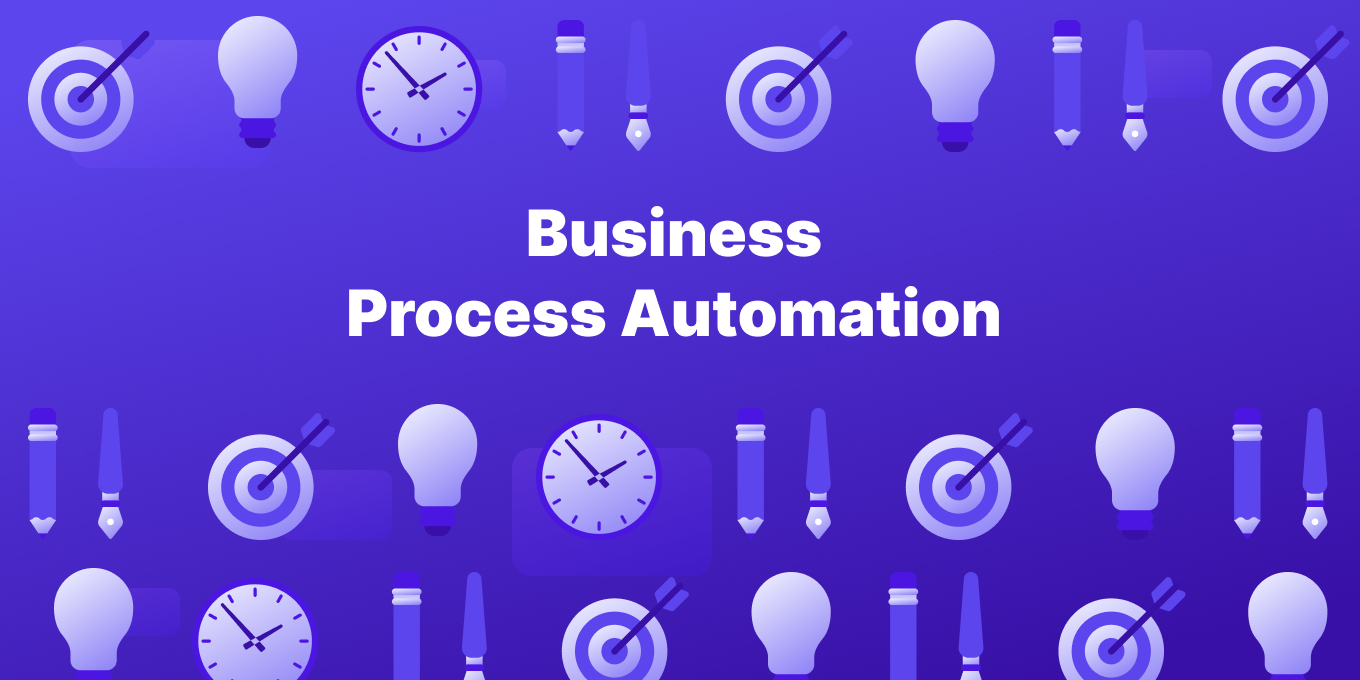Automation is your ticket to building a future-ready business. Don’t take our word for it—according to IBM:
- 79% of executives from companies scaling intelligent automation expect to outperform competitors in revenue growth.
- 90% of executives from companies scaling intelligent automation told IBM it creates higher-value work for their employees.
Automating business processes helps achieve goals faster, saves time and money, and allows employees to focus on more strategic parts of their job.
In this article, we explain the meaning of business process automation and how it works.
What is business process automation?
Business process automation (BPA) involves using technology to automate repetitive tasks.
Automation allows you and your team to focus on strategic tasks.
For example, AI can automate data entry, eliminating the need for someone to manually record sales in a journal.
Instead of recording inventory, you can hire a person who can forecast sales and analyze demand over the next quarter to ensure you don’t under or overstock.
What are the benefits of business process automation?
Here are some key benefits of business process automation:
1. Optimal use of employee time
Since automation takes care of repetitive tasks, employees can focus on more meaningful tasks that require a human touch.
This helps achieve the company’s goals faster. You still need excellent team members, though.
“Rather than representing a threat to the workforce, robots are best thought of as a complementary workforce, working hand-in-hand with people to help them improve their performance and focus their time on other, higher-priority tasks, strategy and innovation.”
– EY
2. Process efficiency
Business automation can fast-track internal processes.
For example, when a prospect fills out the contact form, the automated process can notify the sales team via Slack and create a profile for the lead in your CRM.
Sales reps can directly move on to answering a prospect’s questions without wasting time with manual processes, adding data to the CRM.
3. Accurate data
95% of business leaders reported a negative impact on business because of poor data quality. Automation can address this by facilitating information transfer across apps.
Many business tools offer extensive analytics and reporting tools that use this data to offer great insights.
These insights help you make data-driven decisions that can help reduce costs.
4. Better customer experience
Jeff Toister surveyed 3,200 consumers in 2020 and found that 88% of consumers expect a response to an email in less than one hour.
The average response time? 12 hours.
Companies are already realizing the need for speed when it comes to responding to customers. And many are using conversational AI-powered chatbots to provide faster responses.
81% of customers want to self-serve, and that’s where AI can help.
AI chatbots can provide real-time answers to customers and prospects. If the chatbot fails to provide a helpful answer, it can connect the customer to support or sales.
Types of business process automation
Business process automation can take several forms, as explained below:
Robotic process automation (RPA)
RPA is an automation technology that takes business process management to the next level. It automates repetitive tasks at scale.
You can use RPA to automate the entire process or some parts of it. And that’s why 80% of finance leaders have implemented or plan to implement RPA.
While RPA can’t make cognitive decisions, you can program an RPA system to respond a certain way based on an event.
RPA uses a trigger-and-action mechanism where each event triggers a predefined action.
For example, RPA can automatically update your books of accounts, generate an invoice, and send a welcome email when you make a sale.
However, RPA can’t automatically optimize any of your business processes.
“The match between RPA and business processes isn’t a perfect one if the goal is to redesign or improve the process rather than to automate its current state.”
– HBR
Workflow automation
Workflow automation involves automating and streamlining the flow of tasks in your work environment.
Unlike RPA, workflow automation doesn’t necessarily rely on making rule-based decisions. It follows a standardized process to ensure consistency.
For example, workflow automation can help ensure that your incident reports get properly flagged and taken care of. Read more about customer service workflows.
Trello is a great example of a automation and workflow management tool.
Trello lets you automate the movement of tasks through the workflow. It creates a centralized database of information and documents in the process and helps maintain accountability.
Digital process automation (DPA)
DPA combines the use of bots, data, and automation systems to automate multiple tasks in a digital process.
DPA can help automate repetitive tasks in digital processes like onboarding, invoicing, and credit approvals.
Here are the three categories of work you can automate using DPA:
- Programmatic: Repetitive manual tasks such as data entry and supplying inputs for other systems.
- Transactional: Transactional work includes processes that require some human intervention. Creating the company’s financial documents and processing mortgage applications are great examples.
- Exploratory: Exploratory work involves complex tasks where it’s not possible to prescribe a standard procedure. Examples include forensic accounting and fraud investigations.
Low-code platforms for business automation
Gartner estimates that 75% of major companies will use at least four low-code platforms by 2024.
Low-code platforms offer user-friendliness as well as the flexibility to customize automation for someone who can code.
Zapier, Integromat, and Salesforce Lightning are excellent examples of low-code platforms that can help you automate tasks with more flexibility than ready-to-use process automation tools.

Get more info about processes & documentation from Tettra
- 15 best online documentation tools
- What is process mapping?
- The top process documentation tools
- Why you need project documentation
- How to build effective product documentation
- How to document your processes
- The types of business process documentation you need
- How good team documentation boosts productivity
Implementing business process automation
Randomly signing up for automation tools is a recipe for poor implementation.
Automating processes requires strategy — here’s an overview of how you can implement business process automation:
Defining the goals and objectives of business process automation
Start by identifying your goals with automation. Ask yourself what challenges you have that automation can solve.
Do you need more operational efficiency? Is your goal to reduce costs by 10%? Do you want your employees to focus on nuanced problems while automation takes care of mundane tasks?
Answering these questions will give you a great starting point.
Mapping out your existing business processes
Business process mapping involves outlining the steps in a process along with the task owners and deadlines.
A process map gives you an overview of all processes, so you can look for inefficiencies in the process.
You can use process visualization technologies like process mining and task mining to help visualize and analyze processes.
Identifying manual tasks that can be automated
Find tasks that are repetitive or prone to error and don’t require human intervention.
For example, creating or updating the customer profile in the CRM is repetitive, prone to human error, and doesn’t require human intervention.
If you create or update customer profiles on your CRM whenever you get a new customer or they submit a support ticket, consider automating this task.
Look for similar tasks and see if you can automate them. Do a cost-benefit analysis to understand if it’s worth automating a task given the cost of the required automation tool.
Designing an efficient and effective workflow
Once you’ve identified the tasks you can automate, design an efficient and effective workflow.
Create standard operating procedures (SOPs) to provide everyone with a quick overview.
You can add SOPs to your knowledge base or company wiki so everyone in the team always knows the next step, current status, and tasks they’re responsible for.
SOPs also inform employees about automated tasks and how information flows through those tasks.
Choosing the right business process automation software
Choosing the right business process automation tool (BPA) is important. Picking a tool that’s not a fit for your needs can introduce various challenges, like the inability to transfer data between two systems.
Here are key things to consider when choosing a BPA tool:
- Customizability: You need a solution that matches your needs and is customizable so it can adapt to evolving needs.
- User-friendliness: Tools with a steep learning curve cost more in the long term because you’ll have to spend more on training and repeat the process each time you hire a new employee. An automation platform with an intuitive, user-friendly interface is more cost-efficient.
- Reporting: Comprehensive reporting enables you to identify room for improvement and track the effectiveness of current automation strategies.
- Support: How fast does support respond when you need help? You want a support team that offers help in real time and via multiple channels (live chat, phone, and email). Reading testimonials can give you an idea of how quickly the support team responds.
Monitoring and controlling your business processes
Once you’ve automated business processes, you need to monitor them to identify potential or actual problems.
Here are the three process monitoring approaches you should consider using:
- Functional monitoring: Functional monitoring involves assessing the availability and functionality of the tool’s use cases in a specific process. Once you’ve analyzed an automation tool, you’ll need to interpret your findings in the context of the business as a whole.
- Technical business process monitoring: Technical business process monitoring involves analyzing the performance of software or equipment. But unlike functional monitoring, it helps gauge system efficiency as a whole rather than at the process level.
- Process monitoring: Process monitoring is a convergence of functional and technical business process monitoring. It involves comparing the automation tool’s performance and how it integrates within a specific process.
Drive your business into the future with process automation
Automation empowers your employees by handling repetitive tasks. It allows employees to focus on strategic tasks or tasks that require creativity.
Once you implement business process automation, create a knowledge base that outlines the SOPs. The wiki works as a reference point for current employees and serves as training material for new hires.
Follow the process outlined in this guide to automate business processes and maximize efficiency and profitability.
How Tettra Helps with Business Process Automation
Tettra enhances business process automation by providing a centralized knowledge base that makes it easy for teams to access SOPs, workflows, and essential company information. Here’s how Tettra can help:
- Streamlines Access to Information: With Tettra, employees can quickly find the information they need, reducing downtime and boosting productivity.
- Supports Consistency: By housing updated processes and guidelines, Tettra ensures that everyone follows the same procedures, which is crucial for maintaining efficiency in automated workflows.
- Integrates with Key Tools: Tettra integrates quickly with platforms like Slack, allowing for instant access to information directly within the tools your team already uses.
- Empowers Strategic Focus: By reducing the need to manually search for process documentation, Tettra frees up your team to focus on strategic tasks that drive growth and innovation.
Overall, Tettra is an essential component in the business process automation landscape, making it easier to manage and optimize automated workflows across your organization.


